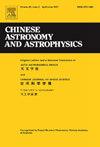Batch Measurement and Calibration Method of DSRT Three-axis Low Frequency Antenna Pointing Error
Q4 Physics and Astronomy
引用次数: 0
Abstract
Daocheng Solar Radio Telescope (DSRT) is an important part of the solar interplanetary exploration subsystem of the Chinese Meridian Project-Phase II. It operates in the 150450 MHz frequency band, providing high-time, high-angular resolution images of the solar radio burst. Aiming at the high precision pointing measurement of the DSRT antenna and the requirement of batch calibration of pointing errors, the antenna's 3-parameter encoder zero-point offset pointing error model is established by quaternion rotation transformation method according to the unique 3-axis mount system of the DSRT. Then, the drift scanning method based on radio source is proposed to obtain the radiation power pattern of the 16 antennas, and the pointing errors are accurately measured by determining the boresight according to the 2-dimensional power pattern. Finally, the least square method is used to fit the model parameters, and the encoder zero point is readjusted for each axis via antenna control software. Verification of the adjustment results confirmed the reliability and effectiveness of the pointing calibration method. After correction, the pointing accuracy of 16 antennas is within 0.5, which is significantly better than the pointing error of 3.5 before calibration, meeting the requirement that errors are less than 1/10 of the HBPW (half power beam width) at the highest operating frequency of the DSRT antenna.
DSRT三轴低频天线指向误差的批量测量与校准方法
稻城太阳射电望远镜是中国子午线工程二期太阳行星际探测分系统的重要组成部分。它在150 - 450 MHz频段工作,提供太阳射电暴的高时间、高角度分辨率图像。针对DSRT天线的高精度指向测量和批量标定指向误差的要求,根据DSRT独特的三轴安装系统,采用四元数旋转变换方法建立了天线的三参数编码器零点偏移指向误差模型。然后,提出了基于射源的漂移扫描方法,获得了16根天线的辐射功率图,并根据二维功率图确定了天线的轴视,精确测量了指向误差。最后利用最小二乘法对模型参数进行拟合,并通过天线控制软件对各轴的编码器零点进行重新调整。通过对平差结果的验证,验证了该方法的可靠性和有效性。校正后,16根天线的指向精度在0.5°以内,明显优于标定前3.5°的指向误差,满足了DSRT天线在最高工作频率下误差小于HBPW(半功率波束宽度)1/10的要求。
本文章由计算机程序翻译,如有差异,请以英文原文为准。
求助全文
约1分钟内获得全文
求助全文
来源期刊

Chinese Astronomy and Astrophysics
Physics and Astronomy-Astronomy and Astrophysics
CiteScore
0.70
自引率
0.00%
发文量
20
期刊介绍:
The vigorous growth of astronomical and astrophysical science in China led to an increase in papers on astrophysics which Acta Astronomica Sinica could no longer absorb. Translations of papers from two new journals the Chinese Journal of Space Science and Acta Astrophysica Sinica are added to the translation of Acta Astronomica Sinica to form the new journal Chinese Astronomy and Astrophysics. Chinese Astronomy and Astrophysics brings English translations of notable articles to astronomers and astrophysicists outside China.
 求助内容:
求助内容: 应助结果提醒方式:
应助结果提醒方式:


